Orthogonal polynomials¶
An orthogonal polynomial sequence is a sequence of polynomials
where
Orthogonal polynomials are sometimes defined using the differential equations they satisfy (as functions of
For more information, see the Wikipedia article on orthogonal polynomials.
Legendre functions¶
legendre()¶
- mpmath.legendre(n, x)¶
legendre(n, x)evaluates the Legendre polynomialAlternatively, they can be computed recursively using
A third definition is in terms of the hypergeometric function
Plots
# Legendre polynomials P_n(x) on [-1,1] for n=0,1,2,3,4 f0 = lambda x: legendre(0,x) f1 = lambda x: legendre(1,x) f2 = lambda x: legendre(2,x) f3 = lambda x: legendre(3,x) f4 = lambda x: legendre(4,x) plot([f0,f1,f2,f3,f4],[-1,1])
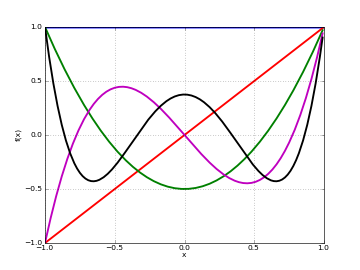
Basic evaluation
The Legendre polynomials assume fixed values at the points
>>> from mpmath import * >>> mp.dps = 15; mp.pretty = True >>> nprint([legendre(n, 1) for n in range(6)]) [1.0, 1.0, 1.0, 1.0, 1.0, 1.0] >>> nprint([legendre(n, -1) for n in range(6)]) [1.0, -1.0, 1.0, -1.0, 1.0, -1.0]
The coefficients of Legendre polynomials can be recovered using degree-
>>> for n in range(5): ... nprint(chop(taylor(lambda x: legendre(n, x), 0, n))) ... [1.0] [0.0, 1.0] [-0.5, 0.0, 1.5] [0.0, -1.5, 0.0, 2.5] [0.375, 0.0, -3.75, 0.0, 4.375]
The roots of Legendre polynomials are located symmetrically on the interval
>>> for n in range(5): ... nprint(polyroots(taylor(lambda x: legendre(n, x), 0, n)[::-1])) ... [] [0.0] [-0.57735, 0.57735] [-0.774597, 0.0, 0.774597] [-0.861136, -0.339981, 0.339981, 0.861136]
An example of an evaluation for arbitrary
>>> legendre(0.75, 2+4j) (1.94952805264875 + 2.1071073099422j)
Orthogonality
The Legendre polynomials are orthogonal on
>>> m, n = 3, 4 >>> quad(lambda x: legendre(m,x)*legendre(n,x), [-1, 1]) 0.0 >>> m, n = 4, 4 >>> quad(lambda x: legendre(m,x)*legendre(n,x), [-1, 1]) 0.222222222222222
Differential equation
The Legendre polynomials satisfy the differential equation
We can verify this numerically:
>>> n = 3.6 >>> x = 0.73 >>> P = legendre >>> A = diff(lambda t: (1-t**2)*diff(lambda u: P(n,u), t), x) >>> B = n*(n+1)*P(n,x) >>> nprint(A+B,1) 9.0e-16
legenp()¶
- mpmath.legenp(n, m, z, type=2)¶
Calculates the (associated) Legendre function of the first kind of degree n and order m,
In terms of the Gauss hypergeometric function, the (associated) Legendre function is defined as
With type=3 instead of type=2, the alternative definition
is used. These functions correspond respectively to
LegendreP[n,m,2,z]andLegendreP[n,m,3,z]in Mathematica.The general solution of the (associated) Legendre differential equation
is given by
legenq().Examples
Evaluation for arbitrary parameters and arguments:
>>> from mpmath import * >>> mp.dps = 25; mp.pretty = True >>> legenp(2, 0, 10); legendre(2, 10) 149.5 149.5 >>> legenp(-2, 0.5, 2.5) (1.972260393822275434196053 - 1.972260393822275434196053j) >>> legenp(2+3j, 1-j, -0.5+4j) (-3.335677248386698208736542 - 5.663270217461022307645625j) >>> chop(legenp(3, 2, -1.5, type=2)) 28.125 >>> chop(legenp(3, 2, -1.5, type=3)) -28.125
Verifying the associated Legendre differential equation:
>>> n, m = 2, -0.5 >>> C1, C2 = 1, -3 >>> f = lambda z: C1*legenp(n,m,z) + C2*legenq(n,m,z) >>> deq = lambda z: (1-z**2)*diff(f,z,2) - 2*z*diff(f,z) + \ ... (n*(n+1)-m**2/(1-z**2))*f(z) >>> for z in [0, 2, -1.5, 0.5+2j]: ... chop(deq(mpmathify(z))) ... 0.0 0.0 0.0 0.0
legenq()¶
- mpmath.legenq(n, m, z, type=2)¶
Calculates the (associated) Legendre function of the second kind of degree n and order m,
The Legendre functions of the second kind give a second set of solutions to the (associated) Legendre differential equation. (See
legenp().) Unlike the Legendre functions of the first kind, they are not polynomials ofThere are various ways to define Legendre functions of the second kind, giving rise to different complex structure. A version can be selected using the type keyword argument. The type=2 and type=3 functions are given respectively by
where
These functions correspond to
LegendreQ[n,m,2,z](orLegendreQ[n,m,z]) andLegendreQ[n,m,3,z]in Mathematica. The type=3 function is essentially the same as the function defined in Abramowitz & Stegun (eq. 8.1.3) but withExamples
Evaluation for arbitrary parameters and arguments:
>>> from mpmath import * >>> mp.dps = 25; mp.pretty = True >>> legenq(2, 0, 0.5) -0.8186632680417568557122028 >>> legenq(-1.5, -2, 2.5) (0.6655964618250228714288277 + 0.3937692045497259717762649j) >>> legenq(2-j, 3+4j, -6+5j) (-10001.95256487468541686564 - 6011.691337610097577791134j)
Different versions of the function:
>>> legenq(2, 1, 0.5) 0.7298060598018049369381857 >>> legenq(2, 1, 1.5) (-7.902916572420817192300921 + 0.1998650072605976600724502j) >>> legenq(2, 1, 0.5, type=3) (2.040524284763495081918338 - 0.7298060598018049369381857j) >>> chop(legenq(2, 1, 1.5, type=3)) -0.1998650072605976600724502
Chebyshev polynomials¶
chebyt()¶
- mpmath.chebyt(n, x)¶
chebyt(n, x)evaluates the Chebyshev polynomial of the first kindThe Chebyshev polynomials of the first kind are a special case of the Jacobi polynomials, and by extension of the hypergeometric function
Plots
# Chebyshev polynomials T_n(x) on [-1,1] for n=0,1,2,3,4 f0 = lambda x: chebyt(0,x) f1 = lambda x: chebyt(1,x) f2 = lambda x: chebyt(2,x) f3 = lambda x: chebyt(3,x) f4 = lambda x: chebyt(4,x) plot([f0,f1,f2,f3,f4],[-1,1])
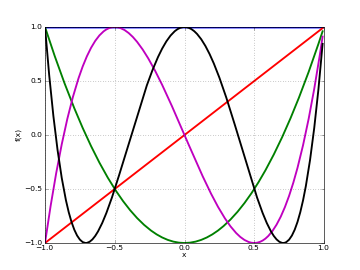
Basic evaluation
The coefficients of the
>>> from mpmath import * >>> mp.dps = 15; mp.pretty = True >>> for n in range(5): ... nprint(chop(taylor(lambda x: chebyt(n, x), 0, n))) ... [1.0] [0.0, 1.0] [-1.0, 0.0, 2.0] [0.0, -3.0, 0.0, 4.0] [1.0, 0.0, -8.0, 0.0, 8.0]
Orthogonality
The Chebyshev polynomials of the first kind are orthogonal on the interval
>>> f = lambda x: chebyt(m,x)*chebyt(n,x)/sqrt(1-x**2) >>> m, n = 3, 4 >>> nprint(quad(f, [-1, 1]),1) 0.0 >>> m, n = 4, 4 >>> quad(f, [-1, 1]) 1.57079632596448
chebyu()¶
- mpmath.chebyu(n, x)¶
chebyu(n, x)evaluates the Chebyshev polynomial of the second kindThe Chebyshev polynomials of the second kind are a special case of the Jacobi polynomials, and by extension of the hypergeometric function
Plots
# Chebyshev polynomials U_n(x) on [-1,1] for n=0,1,2,3,4 f0 = lambda x: chebyu(0,x) f1 = lambda x: chebyu(1,x) f2 = lambda x: chebyu(2,x) f3 = lambda x: chebyu(3,x) f4 = lambda x: chebyu(4,x) plot([f0,f1,f2,f3,f4],[-1,1])

Basic evaluation
The coefficients of the
>>> from mpmath import * >>> mp.dps = 15; mp.pretty = True >>> for n in range(5): ... nprint(chop(taylor(lambda x: chebyu(n, x), 0, n))) ... [1.0] [0.0, 2.0] [-1.0, 0.0, 4.0] [0.0, -4.0, 0.0, 8.0] [1.0, 0.0, -12.0, 0.0, 16.0]
Orthogonality
The Chebyshev polynomials of the second kind are orthogonal on the interval
>>> f = lambda x: chebyu(m,x)*chebyu(n,x)*sqrt(1-x**2) >>> m, n = 3, 4 >>> quad(f, [-1, 1]) 0.0 >>> m, n = 4, 4 >>> quad(f, [-1, 1]) 1.5707963267949
Jacobi polynomials¶
jacobi()¶
- mpmath.jacobi(n, a, b, z)¶
jacobi(n, a, b, x)evaluates the Jacobi polynomialNote that this definition generalizes to nonintegral values of
Evaluation of Jacobi polynomials
A special evaluation is
>>> from mpmath import * >>> mp.dps = 15; mp.pretty = True >>> jacobi(4, 0.5, 0.25, 1) 2.4609375 >>> binomial(4+0.5, 4) 2.4609375
A Jacobi polynomial of degree
taylor():>>> for n in range(5): ... nprint(taylor(lambda x: jacobi(n,1,2,x), 0, n)) ... [1.0] [-0.5, 2.5] [-0.75, -1.5, 5.25] [0.5, -3.5, -3.5, 10.5] [0.625, 2.5, -11.25, -7.5, 20.625]
For nonintegral
>>> nprint(taylor(lambda x: jacobi(0.5,1,2,x), 0, 4)) [0.309983, 1.84119, -1.26933, 1.26699, -1.34808]
Orthogonality
The Jacobi polynomials are orthogonal on the interval
The orthogonality is easy to verify using numerical quadrature:
>>> P = jacobi >>> f = lambda x: (1-x)**a * (1+x)**b * P(m,a,b,x) * P(n,a,b,x) >>> a = 2 >>> b = 3 >>> m, n = 3, 4 >>> chop(quad(f, [-1, 1]), 1) 0.0 >>> m, n = 4, 4 >>> quad(f, [-1, 1]) 1.9047619047619
Differential equation
The Jacobi polynomials are solutions of the differential equation
We can verify that
jacobi()approximately satisfies this equation:>>> from mpmath import * >>> mp.dps = 15 >>> a = 2.5 >>> b = 4 >>> n = 3 >>> y = lambda x: jacobi(n,a,b,x) >>> x = pi >>> A0 = n*(n+a+b+1)*y(x) >>> A1 = (b-a-(a+b+2)*x)*diff(y,x) >>> A2 = (1-x**2)*diff(y,x,2) >>> nprint(A2 + A1 + A0, 1) 4.0e-12
The difference of order
>>> A0, A1, A2 (26560.2328981879, -21503.7641037294, -5056.46879445852)
Gegenbauer polynomials¶
gegenbauer()¶
- mpmath.gegenbauer(n, a, z)¶
Evaluates the Gegenbauer polynomial, or ultraspherical polynomial,
When
Examples
Evaluation for arbitrary arguments:
>>> from mpmath import * >>> mp.dps = 25; mp.pretty = True >>> gegenbauer(3, 0.5, -10) -2485.0 >>> gegenbauer(1000, 10, 100) 3.012757178975667428359374e+2322 >>> gegenbauer(2+3j, -0.75, -1000j) (-5038991.358609026523401901 + 9414549.285447104177860806j)
Evaluation at negative integer orders:
>>> gegenbauer(-4, 2, 1.75) -1.0 >>> gegenbauer(-4, 3, 1.75) 0.0 >>> gegenbauer(-4, 2j, 1.75) 0.0 >>> gegenbauer(-7, 0.5, 3) 8989.0
The Gegenbauer polynomials solve the differential equation:
>>> n, a = 4.5, 1+2j >>> f = lambda z: gegenbauer(n, a, z) >>> for z in [0, 0.75, -0.5j]: ... chop((1-z**2)*diff(f,z,2) - (2*a+1)*z*diff(f,z) + n*(n+2*a)*f(z)) ... 0.0 0.0 0.0
The Gegenbauer polynomials have generating function
>>> a, z = 2.5, 1 >>> taylor(lambda t: (1-2*z*t+t**2)**(-a), 0, 3) [1.0, 5.0, 15.0, 35.0] >>> [gegenbauer(n,a,z) for n in range(4)] [1.0, 5.0, 15.0, 35.0]
The Gegenbauer polynomials are orthogonal on
>>> a, n, m = 2.5, 4, 5 >>> Cn = lambda z: gegenbauer(n, a, z, zeroprec=1000) >>> Cm = lambda z: gegenbauer(m, a, z, zeroprec=1000) >>> chop(quad(lambda z: Cn(z)*Cm(z)*(1-z**2)*(a-0.5), [-1, 1])) 0.0
Hermite polynomials¶
hermite()¶
- mpmath.hermite(n, z)¶
Evaluates the Hermite polynomial
The Hermite polynomials are orthogonal on
for
Plots
# Hermite polynomials H_n(x) on the real line for n=0,1,2,3,4 f0 = lambda x: hermite(0,x) f1 = lambda x: hermite(1,x) f2 = lambda x: hermite(2,x) f3 = lambda x: hermite(3,x) f4 = lambda x: hermite(4,x) plot([f0,f1,f2,f3,f4],[-2,2],[-25,25])
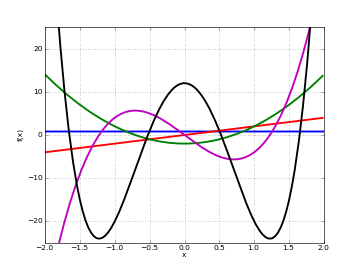
Examples
Evaluation for arbitrary arguments:
>>> from mpmath import * >>> mp.dps = 25; mp.pretty = True >>> hermite(0, 10) 1.0 >>> hermite(1, 10); hermite(2, 10) 20.0 398.0 >>> hermite(10000, 2) 4.950440066552087387515653e+19334 >>> hermite(3, -10**8) -7999999999999998800000000.0 >>> hermite(-3, -10**8) 1.675159751729877682920301e+4342944819032534 >>> hermite(2+3j, -1+2j) (-0.07652130602993513389421901 - 0.1084662449961914580276007j)
Coefficients of the first few Hermite polynomials are:
>>> for n in range(7): ... chop(taylor(lambda z: hermite(n, z), 0, n)) ... [1.0] [0.0, 2.0] [-2.0, 0.0, 4.0] [0.0, -12.0, 0.0, 8.0] [12.0, 0.0, -48.0, 0.0, 16.0] [0.0, 120.0, 0.0, -160.0, 0.0, 32.0] [-120.0, 0.0, 720.0, 0.0, -480.0, 0.0, 64.0]
Values at
>>> for n in range(-5, 9): ... hermite(n, 0) ... 0.02769459142039868792653387 0.08333333333333333333333333 0.2215567313631895034122709 0.5 0.8862269254527580136490837 1.0 0.0 -2.0 0.0 12.0 0.0 -120.0 0.0 1680.0
Hermite functions satisfy the differential equation:
>>> n = 4 >>> f = lambda z: hermite(n, z) >>> z = 1.5 >>> chop(diff(f,z,2) - 2*z*diff(f,z) + 2*n*f(z)) 0.0
Verifying orthogonality:
>>> chop(quad(lambda t: hermite(2,t)*hermite(4,t)*exp(-t**2), [-inf,inf])) 0.0
Laguerre polynomials¶
laguerre()¶
- mpmath.laguerre(n, a, z)¶
Gives the generalized (associated) Laguerre polynomial, defined by
With
The Laguerre polynomials are orthogonal with respect to the weight
Plots
# Hermite polynomials L_n(x) on the real line for n=0,1,2,3,4 f0 = lambda x: laguerre(0,0,x) f1 = lambda x: laguerre(1,0,x) f2 = lambda x: laguerre(2,0,x) f3 = lambda x: laguerre(3,0,x) f4 = lambda x: laguerre(4,0,x) plot([f0,f1,f2,f3,f4],[0,10],[-10,10])

Examples
Evaluation for arbitrary arguments:
>>> from mpmath import * >>> mp.dps = 25; mp.pretty = True >>> laguerre(5, 0, 0.25) 0.03726399739583333333333333 >>> laguerre(1+j, 0.5, 2+3j) (4.474921610704496808379097 - 11.02058050372068958069241j) >>> laguerre(2, 0, 10000) 49980001.0 >>> laguerre(2.5, 0, 10000) -9.327764910194842158583189e+4328
The first few Laguerre polynomials, normalized to have integer coefficients:
>>> for n in range(7): ... chop(taylor(lambda z: fac(n)*laguerre(n, 0, z), 0, n)) ... [1.0] [1.0, -1.0] [2.0, -4.0, 1.0] [6.0, -18.0, 9.0, -1.0] [24.0, -96.0, 72.0, -16.0, 1.0] [120.0, -600.0, 600.0, -200.0, 25.0, -1.0] [720.0, -4320.0, 5400.0, -2400.0, 450.0, -36.0, 1.0]
Verifying orthogonality:
>>> Lm = lambda t: laguerre(m,a,t) >>> Ln = lambda t: laguerre(n,a,t) >>> a, n, m = 2.5, 2, 3 >>> chop(quad(lambda t: exp(-t)*t**a*Lm(t)*Ln(t), [0,inf])) 0.0
Spherical harmonics¶
spherharm()¶
- mpmath.spherharm(l, m, theta, phi)¶
Evaluates the spherical harmonic
where
legenp()).Here
Usually spherical harmonics are considered for
Note
spherharm()returns a complex number, even if the value is purely real.Plots
# Real part of spherical harmonic Y_(4,0)(theta,phi) def Y(l,m): def g(theta,phi): R = abs(fp.re(fp.spherharm(l,m,theta,phi))) x = R*fp.cos(phi)*fp.sin(theta) y = R*fp.sin(phi)*fp.sin(theta) z = R*fp.cos(theta) return [x,y,z] return g fp.splot(Y(4,0), [0,fp.pi], [0,2*fp.pi], points=300) # fp.splot(Y(4,0), [0,fp.pi], [0,2*fp.pi], points=300) # fp.splot(Y(4,1), [0,fp.pi], [0,2*fp.pi], points=300) # fp.splot(Y(4,2), [0,fp.pi], [0,2*fp.pi], points=300) # fp.splot(Y(4,3), [0,fp.pi], [0,2*fp.pi], points=300)
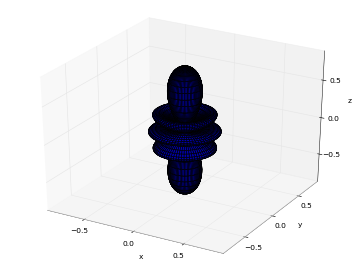
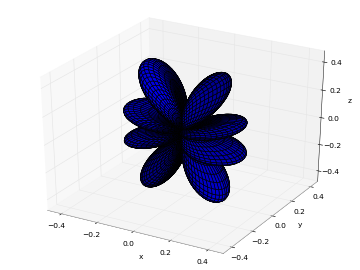


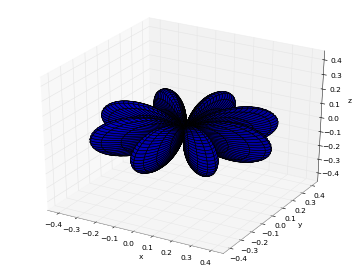
Examples
Some low-order spherical harmonics with reference values:
>>> from mpmath import * >>> mp.dps = 25; mp.pretty = True >>> theta = pi/4 >>> phi = pi/3 >>> spherharm(0,0,theta,phi); 0.5*sqrt(1/pi)*expj(0) (0.2820947917738781434740397 + 0.0j) (0.2820947917738781434740397 + 0.0j) >>> spherharm(1,-1,theta,phi); 0.5*sqrt(3/(2*pi))*expj(-phi)*sin(theta) (0.1221506279757299803965962 - 0.2115710938304086076055298j) (0.1221506279757299803965962 - 0.2115710938304086076055298j) >>> spherharm(1,0,theta,phi); 0.5*sqrt(3/pi)*cos(theta)*expj(0) (0.3454941494713354792652446 + 0.0j) (0.3454941494713354792652446 + 0.0j) >>> spherharm(1,1,theta,phi); -0.5*sqrt(3/(2*pi))*expj(phi)*sin(theta) (-0.1221506279757299803965962 - 0.2115710938304086076055298j) (-0.1221506279757299803965962 - 0.2115710938304086076055298j)
With the normalization convention used, the spherical harmonics are orthonormal on the unit sphere:
>>> sphere = [0,pi], [0,2*pi] >>> dS = lambda t,p: fp.sin(t) # differential element >>> Y1 = lambda t,p: fp.spherharm(l1,m1,t,p) >>> Y2 = lambda t,p: fp.conj(fp.spherharm(l2,m2,t,p)) >>> l1 = l2 = 3; m1 = m2 = 2 >>> fp.chop(fp.quad(lambda t,p: Y1(t,p)*Y2(t,p)*dS(t,p), *sphere)) 1.0000000000000007 >>> m2 = 1 # m1 != m2 >>> print(fp.chop(fp.quad(lambda t,p: Y1(t,p)*Y2(t,p)*dS(t,p), *sphere))) 0.0
Evaluation is accurate for large orders:
>>> spherharm(1000,750,0.5,0.25) (3.776445785304252879026585e-102 - 5.82441278771834794493484e-102j)
Evaluation works with complex parameter values:
>>> spherharm(1+j, 2j, 2+3j, -0.5j) (64.44922331113759992154992 + 1981.693919841408089681743j)